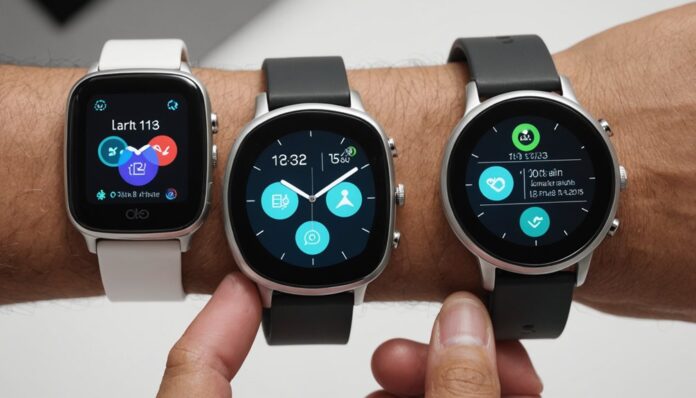Buying a smartwatch requires careful consideration of various features to guarantee the device meets individual needs. Compatibility with one’s phone is essential, as it affects syncing capabilities and overall user experience. Battery life is also a significant factor, with some smartwatches offering more extensive battery life than others. However, the key to a successful smartwatch purchase lies in striking a balance between these features and others, such as health tracking and design options.
Highlights
- Compatibility with your phone’s operating system is crucial for seamless integration and effortless syncing of data and notifications.
- Battery life is a significant factor, varying from a few days to several weeks, with some devices offering power-saving modes and different charging options.
- Activity and health tracking features, such as heart rate and sleep monitoring, should align with your fitness goals and types of activities.
- Display and design options, including screen resolution and strap materials, impact the overall look and user satisfaction of the smartwatch.
- Water resistance and durability features, such as waterproof ratings and material quality, should be evaluated based on intended use and environment.
Compatibility With Your Phone
How seamlessly will a smartwatch integrate with one’s phone? This is a significant consideration for those seeking to purchase a smartwatch. Compatibility with one’s phone is fundamental for a unified experience.
For iPhone users, iOS compatibility is a must, while Android users require Android compatibility. Some smartwatches offer dual compatibility, while others cater exclusively to one operating system.
It’s essential to choose a smartwatch that aligns with one’s phone to guarantee effortless syncing of data, notifications, and apps. When comparing smartwatches, look for models that explicitly state their compatibility with your phone’s operating system.
A compatible smartwatch will enhance user experience, promote a sense of connection, and streamline daily interactions. Checking compatibility beforehand will help buyers make an informed decision and avoid potential pitfalls.
Battery Life Expectations
When evaluating a smartwatch, battery life is a critical factor that greatly impacts the overall user experience. A longer battery life provides users with uninterrupted service and minimal charging hassle.
Battery life expectations vary among smartwatches, ranging from a few days to several weeks. Some devices offer extended battery life through power-saving modes, while others require daily charging.
Charging options also differ, with some smartwatches featuring wireless charging, rapid charging, or solar charging capabilities. Additionally, battery optimization features help prolong battery life by limiting background app activity, reducing screen brightness, and adjusting notification settings.
Understanding a smartwatch’s battery life and charging capabilities is essential for users to determine whether the device meets their lifestyle and usage needs.
Activity and Health Tracking Features
Beyond battery life considerations, a smartwatch’s effectiveness as a fitness companion hinges greatly on its activity and health tracking features. A strong set of tracking features can greatly enhance the user’s experience, providing useful observations into their physical activity and overall well-being.
Heart rate monitoring, for instance, allows users to track their cardiovascular health and optimize their workouts. Sleep monitoring, another essential feature, provides critical information about the user’s sleep patterns, enabling them to make informed decisions about their rest and recovery.
Additionally, features like step tracking, distance tracking, and calorie burn tracking can help users set and achieve their fitness goals. When choosing a smartwatch, users should consider the types of activities they engage in and select a device that offers the relevant tracking features.
Display and Design Options
What makes a smartwatch visually appealing and functional? The display and design options play a significant role in determining its overall aesthetic and user experience.
A smartwatch’s screen resolution is vital, as it affects the clarity and sharpness of the displayed content. Common resolutions include 280×280, 360×360, and 400×400 pixels.
The choice of strap materials also impacts the overall look and feel, with options ranging from leather, metal, and silicone to nylon and ceramic. Additionally, some smartwatches offer interchangeable straps, allowing users to personalize their device to suit their style.
When comparing display and design options, consider how these features will influence daily use and overall satisfaction with the device. A balance between form and function is essential for an ideal user experience.
Water Resistance and Durability
Numerous smartwatches on the market boast water-resistant designs, but the extent of this resistance varies considerably between models. When comparing water resistance and durability, buyers should examine the waterproof ratings, typically measured in meters or atmospheres. A higher rating indicates a smartwatch can withstand greater water pressure.
In addition, material quality plays an essential role in determining a smartwatch’s overall durability. High-quality materials, such as stainless steel or titanium, offer increased resistance to corrosion and wear.
Moreover, the type of glass used for the display can also impact durability, with options like Gorilla Glass or sapphire crystal providing superior scratch resistance.
Buyers should consider their intended use and environment when evaluating a smartwatch’s water resistance and durability features.
App Availability and Customization Options
While a smartwatch’s physical design is important, its functionality is equally significant, and this is heavily influenced by the availability of apps and customization options.
The app ecosystem plays an essential role in enhancing a smartwatch’s functionality, allowing users to access a wide range of tools and services. A thorough app ecosystem provides users with numerous choices, catering to diverse interests and needs.
In addition, personalization features also contribute to a smartwatch’s appeal, enabling users to customize watch faces, notifications, and layouts. Some smartwatches also offer advanced customization options, such as widgets and shortcuts.
Conclusion
A thorough comparison of key features is essential when selecting a smartwatch. Consider compatibility with your phone, battery life, and health tracking capabilities. Evaluate display quality, design options, water resistance, and available apps to enhance functionality and personalization. By assessing these factors, individuals can make an informed decision and choose a smartwatch that meets their specific needs and preferences, ultimately enhancing their overall user experience.


